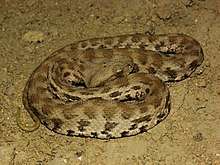Macrovipera lebetina obtusa
Macrovipera lebetina obtusa is a venomous viper subspecies[4] endemic to Asia, from central Turkey to northern Pakistan (Kashmir).
| Macrovipera lebetina obtusa | |
|---|---|
 | |
| Scientific classification | |
| Kingdom: | Animalia |
| Phylum: | Chordata |
| Class: | Reptilia |
| Order: | Squamata |
| Suborder: | Serpentes |
| Family: | Viperidae |
| Genus: | Macrovipera |
| Species: | M. lebetina |
| Subspecies: | M. l. obtusa |
| Trinomial name | |
| Macrovipera lebetina obtusa (Dwigubsky, 1832) | |
| Synonyms[1] | |
Description
It can be distinguished from other subspecies of M. lebetina by its higher scale counts — usually 170-175 ventrals, and 25 (sometimes 27) rows of dorsal scales at midbody — and relatively dark color pattern.[5]
Geographic range
It is found from central Turkey through Syria, Lebanon, Iraq, northern Jordan, the Caucasus region (incl. Armenia), Azerbaijan, Dagestan, Iran, southern Afghanistan, Pakistan and the (Kashmir region). In Pakistan, according to Khan (1983), M. lebetina is restricted to the western highlands; it is allopatric with Daboia russelii, which occurs in the Indus River valley.[5]
References
- McDiarmid RW, Campbell JA, Touré T. 1999. Snake Species of the World: A Taxonomic and Geographic Reference, Volume 1. Washington, District of Columbia: Herpetologists' League. 511 pp. ISBN 1-893777-00-6 (series). ISBN 1-893777-01-4 (volume).
- Steward JW. 1971. The Snakes of Europe. Cranbury, New Jersey: Associated University Press (Fairleigh Dickinson University Press). 238 pp. LCCCN 77-163307. ISBN 0-8386-1023-4.
- Mehrtens JM. 1987. Living Snakes of the World in Color. New York: Sterling Publishers. 480 pp. ISBN 0-8069-6460-X.
- "Macrovipera lebetina obtusa". Integrated Taxonomic Information System. Retrieved 10 August 2006.
- Mallow D, Ludwig D, Nilson G. 2003. True Vipers: Natural History and Toxinology of Old World Vipers. Malabar, Florid: Krieger Publishing Company. 359 pp. ISBN 0-89464-877-2.
Further reading
- Dwigubsky IA. Opyt Estestvennoi Istorii Vsech Zhivotnych Rossiskoi Imperii [Essay on the Natural History of the Animals of the Russian Empire]. Moscow: [Moscow Imperial University]. (in Russian).
- Engelmann W-E, Fritzsche J, Günther R, Obst FJ. 1993. Lurche und Kriechtiere Europas. Radebeul, Germany: Neumann Verlag. 440 pp. (including 324 color plates, 186 figures, 205 maps).
- Golay P, Smith HM, Broadley DG, Dixon JR, McCarthy CJ, Rage J-C, Schätti B, Toriba M. 1993. Endoglyphs and Other Major Venomous Snakes of the World: A Checklist. Geneva: Azemiops Herpetological Data Center. 478 pp.
- Khan MS. 1983. Venomous terrestrial snakes of Pakistan. The Snake 15 (2): 101-105.
- Obst FJ. Zur Kenntnis der Schlangengattung Vipera. Zool. Abh. staatl. Mus. Tierkunde Dresden 38: 229-235.
External links
| Wikimedia Commons has media related to Macrovipera lebetina. |
- Macrovipera lebetina at the Reptarium.cz Reptile Database. Accessed 9 August 2007.
This article is issued from Wikipedia. The text is licensed under Creative Commons - Attribution - Sharealike. Additional terms may apply for the media files.